
Muhlenbergia schreberi, the nimblewill, is a grass species native to North America.
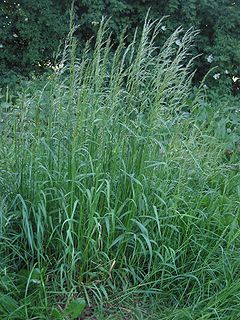
Arrhenatherum elatius, with the common names false oat-grass, tall oat-grass, tall meadow oat, onion couch and tuber oat-grass, is a perennial species of grass, native to Europe, western Asia, and northern Africa.
Muhlenbergia andina, known by the common name foxtail muhly, is a species of grass.
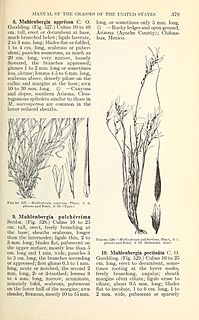
Muhlenbergia appressa, the Devils Canyon muhly, is a species of grass. It is native to the desert region where California and Arizona border Baja California. Muhlenbergia appressa has also been collected on San Clemente Island, one of the Channel Islands of California, in the chaparral and woodlands habitat..

Muhlenbergia filiformis, known by the common name pullup muhly, is a species of grass. It is native to western North America from western Canada through the Western United States to northern Mexico.

Muhlenbergia microsperma is a species of grass known by the common name littleseed muhly. It is native to the Americas from the Southwestern United States and California through Central America into Peru and Venezuela.
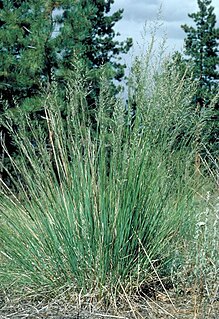
Muhlenbergia montana, the mountain muhly, is a species of grass. It is native to North and Central America, where it is found throughout the Western United States, the Sierra Nevada, Mexico, and Guatemala.
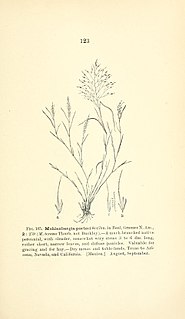
Muhlenbergia porteri is a species of grass known by the common names bush muhly and Porter's muhly.

Muhlenbergia richardsonis, known by the common name mat muhly, is a species of grass. It is native to North America, where it can be found throughout much of Canada, Alaska, the western half of the contiguous United States through California, and in Baja California, Mexico.
Muhlenbergia utilis is a species of grass known by the common name aparejograss.

Panicum dichotomiflorum, known by the common names fall panicgrass, autumn millet, and fall panicum is a species of Poaceae "true grass". It is native to much of the eastern United States and parts of Canada, and it can be found in the Western United States through California. It may be an introduced species in some western climates. It grows in many types of habitat, including disturbed areas and chaparral habitats.

Muhlenbergia cuspidata is a species of grass known by the common name plains muhly. It is native to North America where it is distributed across central Canada and the central United States.

Muhlenbergia glomerata is a species of grass known as spiked muhly and marsh muhly. It is native to North America, where it occurs across Canada and the northern half of the United States.
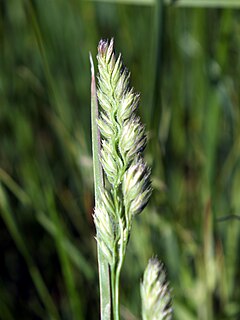
Muhlenbergia racemosa is a species of grass known by the common names green muhly and marsh muhly. It is native to North America, where it is most common in the north-central United States. It also occurs in the western United States and northern Mexico.
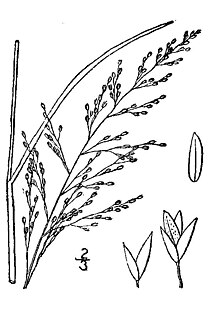
Muhlenbergia torreyana is a species of grass known by the common names New Jersey muhly, Torrey's muhly, and Torrey's dropseed. It is native to the eastern United States, where today it occurs in Maryland, New Jersey, North Carolina, and Tennessee. It has been extirpated from Delaware, Georgia, and New York.

Muhlenbergia capillaris, commonly known as the hairawn muhly, is a perennial sedge-like plant that grows to be about 30–90 cm (0.98–2.95 ft) tall and 60–90 cm (2.0–3.0 ft) wide. The plant includes a double layer; green, leaf-like structures surround the understory, and purple-pink flowers outgrow them from the bottom up. The plant is a warm-season grass, meaning that leaves begin growth in the summer. During the summer, the leaves stay green, but they morph during the fall to produce a more copper color. The seasonal changes also include the flowers, as they grow out during the fall and stay healthy till the end of autumn. The muhly grows along the border of roads and on plain prairies. The grass clumps into herds, causing bush-like establishments in the area the hairawn muhly inhabits. The flowers are very feathery and add a cloudlike appearance to the top of the grass. It is native to eastern North America and can be used for a multitude of purposes, including ornamental gardening and farming. It was voted 2012 plant of the year by the Garden Club of America.
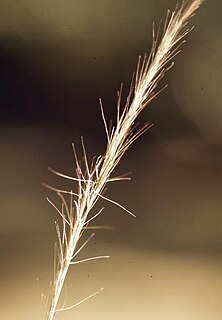
Aristida purpurascens is a species of grass known by the common name arrowfeather threeawn. It is native to eastern North America. One of the three varieties has a distribution extending south into Honduras.

Chloris cucullata is a species of grass known by the common name hooded windmill grass. It is native to the United States, particularly the states of Texas and New Mexico, and adjacent Mexico.
Muhlenbergia lindheimeri is a species of bunch grass, 3-6' H, known by the common names big muhly, blue muhly, and Lindheimer's muhly. It is native to North America, where it can be found in northern Mexico and up to the Edwards Plateau region of Texas. It is also grown as an ornamental grass. as it is useful as a green screen, erosion control, water retention and nest material for many species of birds
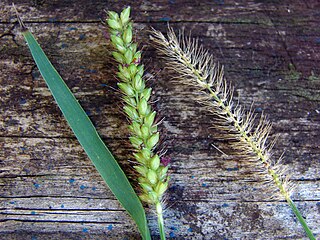
Setaria parviflora is a species of grass known by the common names marsh bristlegrass, knotroot bristle-grass, bristly foxtail and yellow bristlegrass. It is native to North America, including Mexico and the United States from California to the East Coast, Central America and the West Indies, and South America.

















